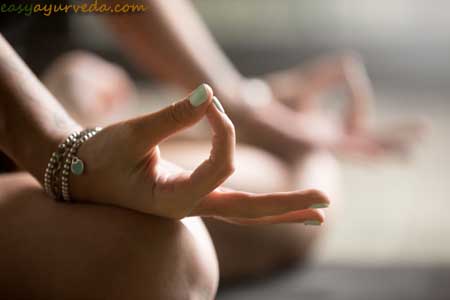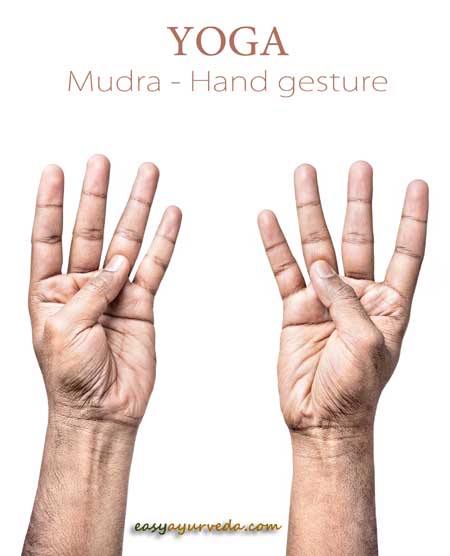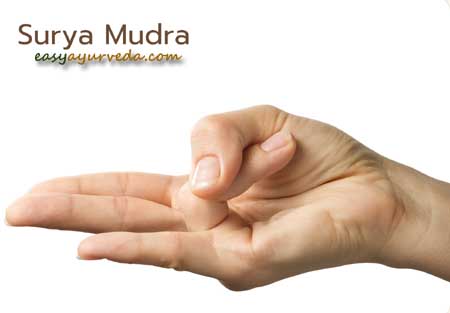Tips To Enhance Effect Of Mudra, 5 Mudra Groups, Rules Of Hasta Mudra

By Dr. Smitha Bhat
Table of Contents
Introduction
The practice of mudra has to be done with calm mind and focusing the concentration on self-body and mind. Regular practice of mudra awakens the inner conscious and self-awareness. One has to follow a breathing pattern to get the best result of practicing Mudra.
The attitudes and postures adopted during Mudra practice establish a direct link between ‘Annamaya Kosha’, the physical body, Manomaya Kosha, the mental body and Pranamaya Kosha, the energy body. Initially, this enables the practitioner to develop awareness of the flow of Prana in the body. Ultimately, it establishes Prana balance within the Koshas and enables the redirection of subtle energy to the upper chakras, inducing higher states of consciousness.
Read related: Mudra – The Science Of Gesture: Benefits, Types, How To Practice
Mudras manipulate Prana in much the same way that energy in the form of light or sound waves is diverted by a mirror or a cliff face. The Nadis and chakras constantly radiate Prana which normally escapes from the body and dissipates into the external world. By creating barriers within the body through practice of mudra, the energy is redirected within. Example: by closing the eyes with the fingers in Shanmukhi Mudra, the Prana being radiated through the eyes is reflected back.
Tantric literature states that once the dissipation of Prana is arrested through the practice of mudra, the mind become introverted, inducing states of Pratyahara (sense withdrawal) and Dharana (concentration). Because of their ability to redirect Prana, Mudras are important techniques for awakening Kundalini. For the same reason they are incorporated extensively in Kriya and Kundalini yoga practices.
Intensifying effect of Mudra
BREATHING AND VISUALIZATION TO ENHANCE THE EFFECT OF MUDRAS
The effect of a mudra can be immensely intensified with the breath. This is why it is very important to know what breathing does. When the following principles are understood, then one can influence the effect of a mudra according to needs.
- Pay attention to a symmetrical posture and hold your arms about one inch away from your body. Even this position alone brings a sense of inner equilibrium and harmony as it regulates the activity of the nervous system and hormonal glands.
- In addition to carbon dioxide, we also discharge expended energy on the subtle level when we exhale deeply. Hence one should always exhale vigorously several times at the beginning of a mudra and then let the breath become deeper and slower.
- Always lengthen the little pause after inhaling and after exhaling by several seconds. This is the most important aspect of the breathing process. The inner powers are developed during the pauses—on every level.
- Slow breathing during the practice of mudra will calm the body and mind.
- Intensified breathing during the practice of mudra will refresh the mind and body.
- The optimal quality of breathing is achieved when the breath is slow, deep, rhythmic, flowing and fine.
Finger pressure variation and breathing
Variations in the pressure in between the fingers and breathing pattern
First: Focus on your hands and fingers; perceive the gentle pressure where they touch each other;
Second: While inhaling, you can press the fingertips together a bit more and let go of the pressure when exhaling;
Third: You can do it the other way around and apply a bit more pressure while exhaling and let go of the pressure when inhaling.
Every variation has its special effect. The first variation centers, creates inner equilibrium, and builds up strength in general. The second variation strengthens the will and refreshes. The third variation calms and relaxes.

Basic rules of Hasta Mudra
1. Tonifying- By touching the tip of the thumb to the base of any finger will increase the element correlating with that finger. Eg: By touching the thumb to the base of the ring finger as in Aditi Mudra, will strengthen the Prithvi Tattva (earth element)
The Thumb symbolizes the Fire
The Forefinger symbolizes the Wind
The Middle finger symbolizes the Ether
The Ring finger symbolizes the Earth
The Little or small finger symbolizes the Water

2. Sedating-
By covering any finger with the thumb, will lead to decrease in the element correlated with that finger. Eg: Covering the ring finger with the thumb, as in Surya Mudra, will decrease the Prithvi Tattva (earth element)

3. Balancing-
By touching the tip of the thumb with the tip of any finger will balance the element associated with finger. Eg: Touching the tips of the thumb and index finger, as in Jnana Mudra, will balance the Vayu Tattva. (air element)
5 groups of Yoga Mudras
Five groups of Yoga Mudras
The Yoga Mudras can be categorized into apparently 5 groups.
1. Hasta (hand mudras)
As the name suggest the hands are involved in the practice of mudra. They redirect the Prana emitted by the hands back into the body. Mudras which join the thumb and other fingers engage the motor cortex at a very subtle level. They generate a loop of energy which moves from the brain down to the hand and then back again. Conscious awareness of this process rapidly leads to internalization. Techniques included in this category are:
Jnana Mudra, Chin Mudra,
Yoni Mudra, Bhairava Mudra, Hridaya Mudra.
2. Mana (head mudras)
These practices form an integral part of Kundalini Yoga and many are meditation techniques in their own right. They utilize the eyes, ears, nose, tongue and lips. Techniques included in this category are: Shambhavi Mudra, Nasikagra Mudra, Khechari
Mudra, Kaki Mudra,
Bhujangini Mudra, Bhoochari Mudra,
Shanmukhi Mudra, Unmani Mudra.
3. Kaya (postural mudras)
These practices utilize physical postures combined with breathing and concentration. Techniques included in this category are: Vipareetakarani Mudra, Pashinee Mudra, Tadagi Mudra, Manduki Mudra
4. Bandha (lock mudras)
These practices combineMudra and Bandha. Bandha are the locks, they charge the system with Prana and prepare it for Kundalini awakening. Techniques included in this category are: Maha Mudra, Mahabandha Mudra, Mahavedha Mudra
5. Adhara (perineal mudras)
These techniques redirect Prana from the lower centres to the brain. Mudras concerned with sublimating sexual energy are in this group. Techniques included in this category are: Ashwini Mudra, Vajroli Mudra.
Between them these 5 groups engage substantial areas of the cerebral cortex. The comparatively large number of head and hand mudras reflects the fact that the operation and interpretation of information coming from these two areas occupies approximately 50% of the cortex.
Mudras are performed either with or after Asana and Pranayama.
Author: Dr. Smitha Bhat
Alva’s Ayurveda Medical College,
Moodabidri, Karnataka
[email protected]









